International Research Journal of Engineering and Technology (IRJET) e ISSN: 2395 0056

Volume: 09 Issue: 07 | July 2022 www.irjet.net p ISSN: 2395 0072

International Research Journal of Engineering and Technology (IRJET) e ISSN: 2395 0056

Volume: 09 Issue: 07 | July 2022 www.irjet.net p ISSN: 2395 0072
Huda Saleem1 , Tabish Ahmed Abdullah2
1 Final Year, M. Arch, Faculty of Architecture and Planning, Dr. APJ AKTU, Lucknow, UP
2 Associate Professor, Faculty of Architecture and Planning, Dr. APJ AKTU, Lucknow, UP ***
Abstract The research, focusing on school buildings, has demonstrated that building features including thermal comfort, lighting, indoor air quality, provision of open spaces impacts the performance of students and teaching staff both physically and psychologically. A high demand for heating energyinwinter,overheatinginsummerandvisualdiscomfort areimportantissuesinschoolbuildingsofIndia.Theresearch includes the detailed examination of the hot and dry climate zone of India and the study of institutional buildings with respect to it. This research will conduct the detailed study of orientation, optimum window to wall ratio, space organization, sun shading, and building shape of an institutional building which will help in the considerable results of the research. For the purpose of this study, a typical elementary school in the hot and dry climate of India is selected, modeled, and analyzed.
Key Words: Optimallearningspaces,Hotanddryclimate, daylight, building simulation, Annual performance, illumination,Daylightperformance
TheneedtostrengthenGovernmentschoolsinIndia.This research examines public primary school design as not governed by the needs of a multi purpose classroom but rather, as the arrangement of integrated learning spaces throughrespondingtotheharshclimaticconditions.Climate baseddesignofschoolbuildingscancontributetosignificant energy savings and improve the students’ learning environment. Thepurposeofthisresearchistoformulate designrecommendationsforpublicschoolbuildingsinthe hotanddryclimaticzoneofIndia.
This research aims to introduce an optimized school designthatmeetsbothinhabitants’comfortneedsandbetter learningenvironmentinaparticularenvironmentofhotand dryclimatezoneofIndia.
1. To understand the hot and dry climate condition anditsadverseeffectsonschoolbuildings.
2. Aninvestigationintodesignprinciplesofreflected daylighting in primary schools in the hot dry climateofRajasthan.
3. To deliver the requirements of learning space throughstandardsandcase/literaturestudies.
4. Todevelopclimateresponsivedesignsolutionswith the purpose of meeting the comfort level in the learningenvironment.
5. To understand how the existing classroom of hot anddryregionperformsintermsofdaylight.
6. Tounderstandtheroleofdaylightdesigninterms oftheperformanceoftheschoolbuilding.
7. Tounderstandhowdifferentdaylightmetrichelps inrecordingdaylightperformance.
8. Toanalyzethepassivedesignstrategiesinthehot anddryclimaticzone.
9. To analyze the applications of passive design strategies in school buildings situated in the hot/dryclimatezone.
Theresearchwillbecontrolledonthedaylightingparameter ofhotanddryclimatefortheinstitutionalbuildingproviding comfortandbettereducationalspace.
1. Theresearchwillbelimitedtothepublicschool.
2. The research will include the hot and dry climate zoneofIndia.
3. The study will be limited to the parameter specifically daylight and further analysis on ventilation,form,andmaterialswhichwillleadtoan enhanceddesignsolution.
4. Thestudywillfocusontheoptimallearningspace.
2.
ThehotanddryclimateofIndiahasplentyofsunshineand whilstitcanbeagreatsourceofenergyandnaturallighting in buildings, has unfortunately caused overheating and discomfort,particularlyininstitutionalbuildings.Itismainly becauseofpoordesignandtechnicalimplementation.This
International Research Journal of Engineering and Technology (IRJET) e ISSN: 2395 0056

Volume: 09 Issue: 07 | July 2022 www.irjet.net p ISSN: 2395 0072
problemisexacerbatedwiththeimplementationofpassive designsolutions.
Solarradiationisagreatsourceofenergyandwithagood understanding of how to use such a valuable resource effectively; buildings can be more energy efficient, using daylightmoreproductivelyandalsobebetterforthewell being of the students. Therefore, based on the above two mainreasons,thehot dryclimatezoneofIndiaisselectedto make more precise research. Having focused on a specific climatezone,itisimportanttoaddresstheclimatechange and sustainable architecture as they support daylighting fromaclimaticandenvironmentalpointofview.
The Jaisalmer sandstone used to construct the Rajkumari Ratnavati Girl's School was hand carved locally by skilled artisansandutilizinglocalresourcestobuildinfrastructure andinstallingasolarpanelcanopyontheroofasacooling systemwhentemperaturescanreachcloseto120degrees helps minimizecarbon emissions. Theschool hasanoval shapedbuildingthatconnectswiththedesertenvironment. Thestructurealsoincludessustainablefeatures.400females fromkindergartentoclassXwillbeabletoattendtheschool section,knownastheGyaanCentre.
Fig. 1:RajkumariRatnavatiGirl’sSchool
Source:https://www.archdaily.com/960824/therajkumari ratnavati girls school diana kellogg architects/60897ade975ec001650b3bae the rajkumari ratnavati girls school diana kellogg architects photo
Fig. 2:PlinthLevelPlan
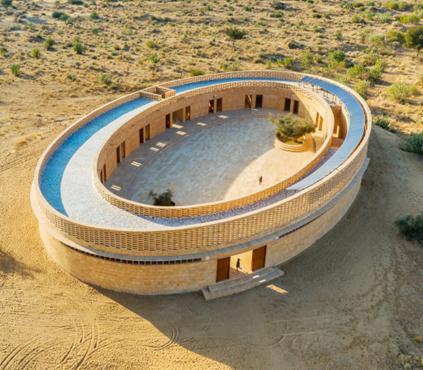
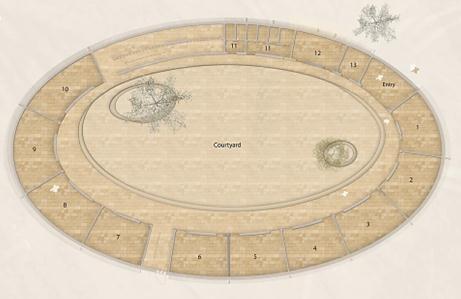

Source: https://www.dkarchitects.com/rajkumariratnavatigirlsscho ol?pgid=kitd4a4f3 c2c1e5cd 14b3 4bf9 9592 5910d2210d80
Fig. 3:RoofPlan
Source: https://www.dkarchitects.com/rajkumariratnavatigirlsscho ol?pgid=kitd4a4f3 d3cb3536 dc54 47c6 a1ab b4535405cc9b
exteriorandinterior
International Research Journal of Engineering and Technology (IRJET) e ISSN: 2395 0056
Volume: 09 Issue: 07 | July 2022 www.irjet.net p ISSN: 2395 0072
Thedaylightfactor(DF)isthemostusedparameterinthe characterizationandquantificationofdaylightinbuildings.
Therepresentativemodeloftheschoolbuilt,islocatedinthe hot and dry climate of Jaisalmer. Each classroom has two twentywindowslocatedthroughoutthewall.
Specificationsanddetails:
1. Parametersconsideredwhiledoingsimulation
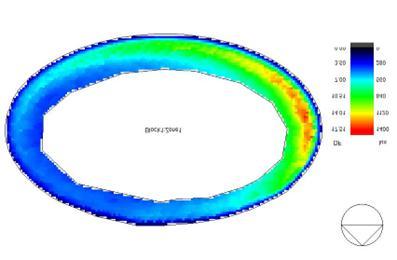
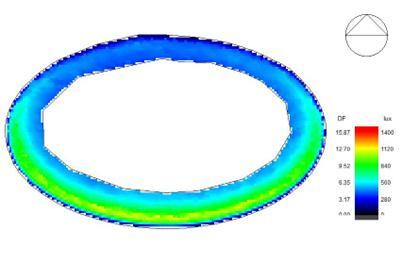
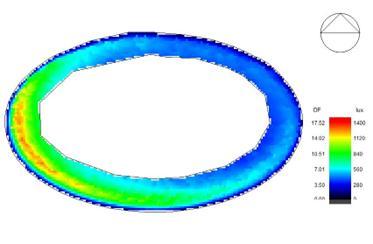
2. Climate HotandDry
3. Location Salkha, Rajasthan,India (Located in the TharDesertintheNorthofIndia)
4. Area 9,000squarefoot
5. Material Stone in abundant therefore, yellow sandstoneusedthroughout.
6. Sizeofwindow 600x600mm
7. Sizeofjail 300x150x50mm
8. Sizeofbrickused 215x102x65mm
9. Wallthickness 300mm
10. The‘u’valueofmaterial ‘sandstone’03.0 0.002
11. Windowtowallratio/windowtowall% 25 12. Windowheight 600mm 13. Windowspacing 150mm
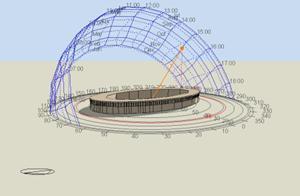
14. Silllevel 2100mm
The sun path diagram of the selected case study of RajkumariRatnavatiGirl'sSchool,Rajasthanareasfollows:
Fig. 5:Sunpathdiagramofthestudiedcaseat3p.m. Generated high quality image to illustrate daylight availabilityandglarewithintheblock:
Fig. 4: Sun path diagram of the studied case at 12 p.m.
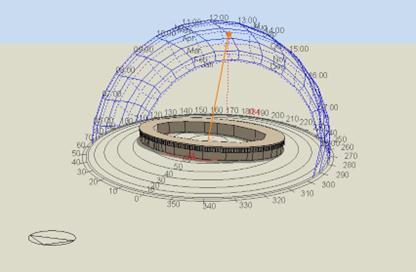
Fig. 6:Daylightilluminanceat9a.m.
Fig. 7:Daylightilluminanceat12p.m.
Fig. 8:Daylightilluminanceat3p.m.
2022, IRJET | Impact Factor value: 7.529 | ISO 9001:2008 Certified

International Research Journal of Engineering and Technology (IRJET) e ISSN: 2395 0056

Volume: 09 Issue: 07 | July 2022 www.irjet.net p ISSN: 2395 0072
Resultanalysisforbasecase:
DaylightFactor(DF)Analysis:80%ofallilluminancesensors haveadaylightfactorof2orhigher.
DaylightAutonomy(DA)Analysis:DArequirements(500lux ormore)aremetoverthetotalareafor87%oftotalannual analysishours.
Useful Daylight Index (UDI) Analysis: The Useful Daylight IndexisUDI<2000=lessthan60%
Gooddaylightingdependson: 1. Amountofdaylightavailable 2. Externalobstructionsandreflectance 3. Internalreflectanceofroomfinishes 4. Proportionofwindowopening 5. Locationofwindowopening 6. Depthofplan
Thisresearchhasemphasizedtheimportanceofdaylighting designontheoverallqualityofschools.Havingreviewedthe standardsanddevelopmentofdaylightinginschools,ithas explored different aspects of daylight influencing schools suchasstudenthealthandperformanceaswell asenergy performance of the building. It has finally delivered some guidelinesandprinciplesofdaylightinginschoolswhichis usefulforschooldesigners.
The hot and dry climate of India is examined and institutional buildings are studied in terms of daylight parameterandfortheresultonespecificnewlyconstructed school in the hot and dry region of India is selected and daylightilluminanceiscalculatedandprovedtobetheideal designforanoptimallearningspaceinthedesertareaofhot and dry region for further design strategies and requirementsforsuchoptimallearningspacedesign.
Theprimarygoalofthestudywastogetanideaabouthow the typical school plan in Jaisalmer, Rajasthan perform in termsofdaylight.
Followingarethemainconclusionsofthestudy: Considering the case studied, the metrics worked in the followingmanner:
daylight factor (df) analysis: classroom space achieved daylightfactorof2for75%ofthespace.
daylightautonomy(da)analysisdarequirements(300lux ormore)aremetoverthetotalareaforatleast75%oftotal annualanalysishoursarefulfilled.
usefuldaylightindex(udi)analysis:theamountofdaylight (500luxormore)penetratinginsidetheclassroomislower (lessthan60%)inthecasethatleadstoglarefreecondition, thus visual and thermal comfort is maintained hence, optimallearningspaceisselectedandidentified.
1) ABDULRAHMAN,I.(May2014).ENERGYEFFICIENT BUILDINGSINAHOTANDDRYCLIMATE.
2) Ai,F.(June2009).ReflectedDaylightinginSchools.
3) Aizlewood, M. E. (n.d.). Innovative daylighting systems:anexperimental.1993.
4) Architectural design optimization of school buildingsforreductionofenergy.(December2013). Retrieved from https://www.researchgate.net/publication/281619 217
5) Barrett, P. (November 2009). Optimal Learning Spaces Design Implications for Primary Schools. SCRIReport2schooldesign . Retrieved from https://www.researchgate.net/publication/228356 048
6) Bittencourt,L.a.(2001).DaylightingofClassrooms throughCourtyards.RiodeJaneiro,Brazil.
7) Costanzo, V. (May 2017). AReview of Daylighting StrategiesinSchools:StateoftheArtandExpected. Retrieved from https://www.researchgate.net/publication/316922 753
8) Cuttle,C.C.(1971).LightingPatternsandtheflow oflight.
9) Donovan,J.J.(1921).SchoolArchitecture:Principles andPractice.MacMillan.
10) G.Manio÷lua,*.G.(2015).EffectofCourtyardShape FactoronHeatingandCoolingEnergyLoadsinHot andDryClimaticZone.ElsevierLtd.Retrievedfrom www.sciencedirect.com http://creativecommons.org/licenses/by nc nd/4.0/).
11) (n.d.). HOT AND DRY CLIMATES Energy Design GuidelinesforHighPerformanceSchools.National RenewableEnergyLaboratory.
International Research Journal of Engineering and Technology (IRJET) e ISSN: 2395 0056
Volume: 09 Issue: 07 | July 2022 www.irjet.net p ISSN: 2395 0072
12) Lam, W. M. (1986). Sunlighting as form giver for architecture.NewYork,Van.
13) Littlefair, P. J. (1989). Innovative daylighting systems.BuildingResearch.
14) Lynes, J. A. (1968). Principles of natural lighting. NewYork,ElsevierPublications.
15) MDKLFJDSI. (n.d.). VFXDGDF. Retrieved from The EffectofGeometricShapeandBuildingOrientation onMinimisingSolar
16) Robbins, C. L. (1986). Daylighting: design and analysis.NewYork,VanNostrand.
17) Simran.(2019).TheEffectofGeometricShapeand BuildingOrientationonMinimisingSolar.
18) Singh,M.K.(December2014).ThermalComfortin Naturally Ventilated Classrooms. Retrieved from https://www.researchgate.net/publication/269819 328
19) Steffy,G.(2002).ArchitecturalLightingDesign.New York:JognWiley&SonsInc.
20) Stewart,D.M.(1981).Attitudesofschoolchildren to daylight and fenestration. Building and Environment(16).
21) SustainableBuildingforHotandAridareas.(n.d.).
22) Von Meiss, P. (1990). Elements of Architecture: fromformtoplace.NewYork:Van.
23) Weinstein,C.S.(1979).ThePhysicalEnvironment oftheSchool:AreviewoftheResearch.Reviewof EducationalResearch.
24) www.energysmartschools.gov. (n.d.). Retrieved fromEnergySmartSchools.
2022, IRJET | Impact Factor value: 7.529 | ISO 9001:2008 Certified
